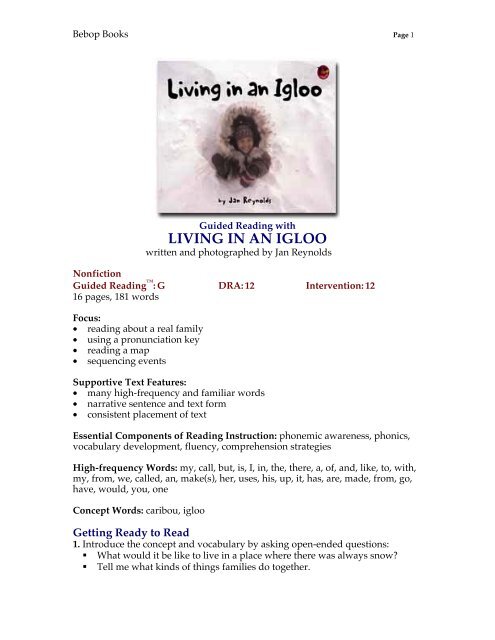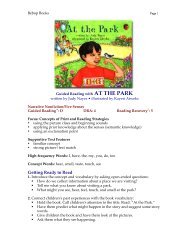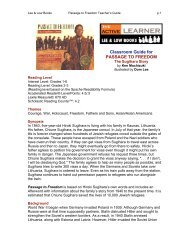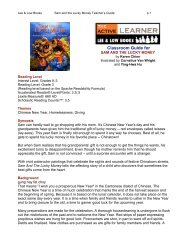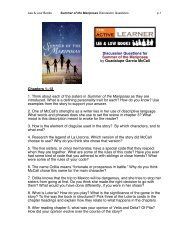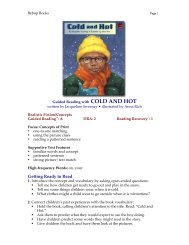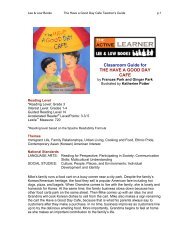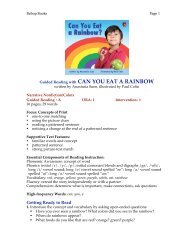Guided Reading with LIVING IN AN IGLOO - Lee & Low Books
Guided Reading with LIVING IN AN IGLOO - Lee & Low Books
Guided Reading with LIVING IN AN IGLOO - Lee & Low Books
Create successful ePaper yourself
Turn your PDF publications into a flip-book with our unique Google optimized e-Paper software.
Bebop <strong>Books</strong> Page 1<strong>Guided</strong> <strong>Reading</strong> <strong>with</strong><strong>LIV<strong>IN</strong>G</strong> <strong>IN</strong> <strong>AN</strong> <strong>IGLOO</strong>written and photographed by Jan ReynoldsNonfiction<strong>Guided</strong> <strong>Reading</strong> : G DRA: 12 Intervention: 1216 pages, 181 wordsFocus:• reading about a real family• using a pronunciation key• reading a map• sequencing eventsSupportive Text Features:• many high-frequency and familiar words• narrative sentence and text form• consistent placement of textEssential Components of <strong>Reading</strong> Instruction: phonemic awareness, phonics,vocabulary development, fluency, comprehension strategiesHigh-frequency Words: my, call, but, is, I, in, the, there, a, of, and, like, to, <strong>with</strong>,my, from, we, called, an, make(s), her, uses, his, up, it, has, are, made, from, go,have, would, you, oneConcept Words: caribou, iglooGetting Ready to Read1. Introduce the concept and vocabulary by asking open-ended questions: What would it be like to live in a place where there was always snow? Tell me what kinds of things families do together.
Bebop <strong>Books</strong> Page 2Do you know what an igloo is? Tell me what you know about igloos. Whatdo you think it would be like to live in an igloo?2. Connect children’s past experiences <strong>with</strong> the book vocabulary: Call children’s attention to the title. Read: “Living in an Igloo.” Ask them to predict what they would expect to see happen in the story. Show the back cover and read the copy. Direct children to consider how thetitle and this sentence help them predict what the story is about. Have children suggest some words they might read in the story. Give children the book and have them look at the pictures. Ask them to tellwhat happens as they turn each page.3. Remind children of the strategies they know and can use <strong>with</strong> unfamiliarwords: Ask them, “What will you do if you come to a word you don’t know?” Encourage children to say the beginning sound of an unknown word andread on, returning to the word after completing the sentence. Suggest that children also think about what they know about igloos andliving in cold climates. Then encourage them to choose a word that wouldmake sense in the sentence. Remind children to use the pronunciation key on page 2 for help <strong>with</strong> thegirl’s name.4. Be aware of the following book and text features: The book contains numerous high-frequency words. The story is written in narrative form and ends <strong>with</strong> a question. All the sentences are different; there are no text patterns. A pronunciation key for the girl’s name is given in the lower right corner ofpage 2. A map is included on page 3 to show the relative location of where thefamily lives. The photographs support and enhance the story.<strong>Reading</strong> the Book1. Set a purpose by telling children to read about the family and what it is like tolive in an igloo.2. Have children read the first few pages quietly, but out loud. Each child shouldbe reading at his or her own pace. Children should not read in chorus. Listen tochildren as they read by leaning close or bending down beside each child. Whenyou hear them reading fluently, tell them to begin reading silently.3. Look for these reading behaviors during children’s first reading: Do they use multiple sources of information? Do they make predictions and confirm or revise them while reading? Are they more able to monitor meaning and to self correct? Do they know a large number of sight words?
Bebop <strong>Books</strong> Page 3Do they use punctuation appropriately?Do they read more automatically and <strong>with</strong> fluency?Have they begun to draw conclusions and make inferences?4. As children read, suggest reading strategies if they are struggling: “Try sayingthe beginning of the word. Try looking at the picture for help.” Encouragechildren to take a guess or read past the unknown word.5. Possible teaching points to address based on your observations: Review how to find a known part in an unknown word. Show children how to use analogies to move from the known to theunknown when encountering new words. Work <strong>with</strong> suffixes and prefixes. Review using grammar (syntax) to unlock words by considering thesentence structure or parts of speech in the sentence. Explore the story grammar—characters, setting, problem, and so on. Review how to determine what is important in a picture or sentence. Model asking questions or making “I wonder . . .” statements to extendcomprehension. Review using punctuation marks to guide the meaning-making process.Point out the hyphenated word “good-bye” on page 14 and talk about whythe word is written this way. Call attention to the pronunciation key as an aid to pronouncing anunknown word. Review using the map on page 3 to help set the context of the story. Model how to revisit the text to find specific examples or ideas in the story.Revisit <strong>LIV<strong>IN</strong>G</strong> <strong>IN</strong> <strong>AN</strong> <strong>IGLOO</strong> to review the sequence of events in buildingan igloo.After the First <strong>Reading</strong>1. Have children compare their predictions <strong>with</strong> what actually happened in thestory.2. Connect children’s own experiences <strong>with</strong> those of the family in the book.Explore the similarities and differences between Daisy’s family and the familiesof children in the group.3. Compare the family in <strong>LIV<strong>IN</strong>G</strong> <strong>IN</strong> THE <strong>IGLOO</strong> <strong>with</strong> the families in THE BESTTH<strong>IN</strong>G and TUTI’S PLAY.4. Talk <strong>with</strong> children about what it means to live in the “far north.” (See page 3 ofthe story.)5. Call children’s attention to the steps in building an igloo. Talk about how anigloo is the same as and different from children’s homes.
Bebop <strong>Books</strong> Page 46. Elicit children’s responses to the question on page 16 and encourage them toshare opinions about living in an igloo. (Make sure children understand that“one” is a pronoun that refers to an igloo.)Second <strong>Reading</strong>1. Have children reread the book silently or to a partner.2. This is a time for assessment. While they are reading, watch what children doand what they use from the teaching time. Alternatively, you might take arunning record on one child as an assessment of the child’s reading behavior.Cross-Curricular ActivitiesArt: Have children draw pictures of their own homes. Then let volunteersdescribe the pictures, pointing out features such as doors, windows, steps, roof,and so on. Children might also label these features or write descriptions of theirhomes.Music: Teach children the chorus and first verse of the song “Home on theRange.”Oh, give me a home, where the buffalo roam,Where the deer and the antelope play,Where seldom is heard a discouraging word,And the skies are not cloudy all day.Chorus:Home, home on the range,Where the deer and the antelope play,Where seldom is heard a discouraging word,And the skies are not cloudy all day.Once children have learned the basic tune and words, innovate on the verse todescribe the setting of the story and the igloo Daisy’s family built. (The completesong lyrics can be found at: www.statehousegirls.net/ks/symbols/song/)Science: Help children build two piles of ice cubes in the shape of an igloo. Putone igloo in the refrigerator or freezer. Leave the other in the classroom. Havechildren observe both igloos every half hour and record what they see on a chart.At the end of the day, reread the observations and have children draw someconclusions.Math: Look up the average summer, fall, winter, and spring temperatures innorthern Canada, in the region indicated by the star on the map on page 3. Thenlook up the average temperatures where you live. Chart the temperatures on agraph and encourage children to make comparisons.Social Studies: Research different kinds of homes around the world. Childrenmay also wish to look through books in the classroom or school library forexamples of different kinds of homes. Display some of the pictures and books<strong>with</strong> the pictures of children’s homes created for the art activity.
Bebop <strong>Books</strong> Page 5Writing: The author, Jan Reynolds, has photographed many different groups ofpeople while living <strong>with</strong> them. (See also TUTI’S PLAY.) Have childrenbrainstorm and record a list of questions they would like to ask the author aboutliving <strong>with</strong> Daisy and her family.<strong>Guided</strong> <strong>Reading</strong> <strong>with</strong>VIVO EN UN IGLÚ<strong>Guided</strong> <strong>Reading</strong> : G DRA: 12 Intervention: 1216 pages, 181 wordsThe directions given for the introduction, first reading, and second reading of theEnglish edition can be used <strong>with</strong> the Spanish edition of the book. To read thebook successfully, children need the same kinds of support as their Englishspeakingclassmates. Second language learners often benefit from acting out newwords, seeing pictures, and talking about them using concrete examples.The Spanish edition has many familiar words and simply constructed sentences.The book contains familiar punctuation marks. The family’s activities should befamiliar to children. Discussion and rereading may be helpful to many childrenreading this book so they understand this family lives in a very cold place.The book language used may differ from children’s oral language. Comparingany differences will help children read and understand the story. Also helpchildren understand that we often speak differently than we write, and that bothways of using language are important.
Bebop <strong>Books</strong> Page 6Contact informationFor more information about Bebop <strong>Books</strong>, please contact:Craig <strong>Low</strong>, PublisherBebop <strong>Books</strong>An imprint of LEE & LOW BOOKS95 Madison Avenue, Suite #606New York, NY 10016212-779-4400 x. 26 ph.212-683-1894 faxclow@bebopbooks.com<strong>Guided</strong> <strong>Reading</strong> <strong>Guided</strong> reading levels have been assigned by <strong>Reading</strong> Recovery ® teachers and literacyexperts using the guidelines identified in <strong>Guided</strong> <strong>Reading</strong> and Matching <strong>Books</strong> to Readers by Irene C. Fountasand Gay Su Pinnell (Heinemann).Intervention Intervention levels have been assigned by certified <strong>Reading</strong> Recovery ® teachers and literacyexperts and are intended for use in early intervention and one-on-one tutorial programs, including <strong>Reading</strong>Recovery ® programs. These levels are not officially authorized by <strong>Reading</strong> Recovery ® . <strong>Reading</strong> Recovery ® isa registered servicemark of The Ohio State University.DRA (Developmental <strong>Reading</strong> Assessment) DRA levels were determined using information in theDevelopmental <strong>Reading</strong> Assessment Resource Guide by Joetta Beaver (Celebration Press).All level placements may vary and are subject to revision. Teachers may adjust the assigned levels inaccordance <strong>with</strong> their own evaluations.Copyright © 2004 by Bebop <strong>Books</strong> ® , an imprint of <strong>Lee</strong> & <strong>Low</strong> <strong>Books</strong> Inc. Used <strong>with</strong> permission


